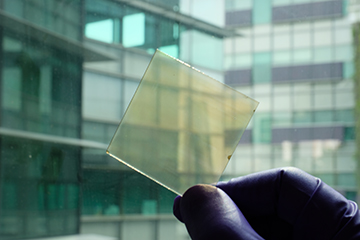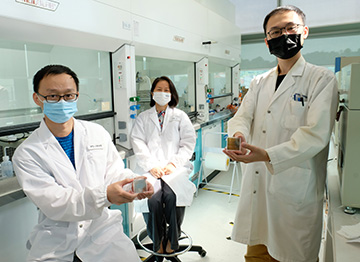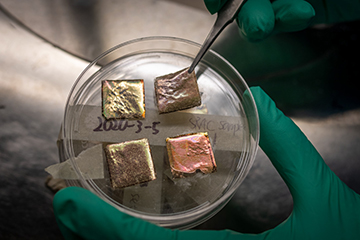
Sample of adaptive glass from team led by Long Yi of Nanyang Technological University, Singapore. Scientists in two research groups have exploited thins films of tungsten-doped vanadium dioxide (VO2) and photonic resonance to show how windows and rooftops can be made to emit thermal radiation in the summer and block it in the winter. [Image: NTU Singapore]
The cold expanses of deep space can be exploited as a heat sink to cool down objects beneath clear skies, thanks to the atmosphere’s transparency at thermal infrared wavelengths. Indeed, such “radiative cooling” has been used to lower buildings’ temperature below that of the surroundings—even on scorching summer days (see “Radiative Cooling: Harvesting the Coldness of the Universe,” OPN, November 2019).
To date, however, this ingenuous energy-saving technique has had a shortcoming: the infrared cooling channel remains open throughout the winter and therefore tends to increase heating bills. Now, two independent groups of researchers have shown how to switch the cooling off in cold weather without any electrical or mechanical triggering, opening the prospect year-round energy savings. The secret? Exploiting a phase transition in tungsten-doped vanadium dioxide (VO2).
One of the research groups has used this temperature-responsive material to reduce heat escaping through windows (Science, doi: 10.1126/science.abg0291). The other has shown how to improve roof-based insulation (Science, doi: 10.1126/science.abf7136).
Window dressing
The work of the two teams is part of a drive to improve the energy efficiency of buildings. According to the United Nations, buildings use up to 40% of the world’s energy. In the United States, it’s been estimated that the heating and cooling associated with windows alone account for 4% of the country’s primary energy consumption.
Long Yi of Nanyang Technological University (NTU), Singapore, and colleagues in Singapore, the United States and China set out to try and better the performance of commercial windows with low-emissivity (low-e) coatings. These rely on layers of metal or metal oxide to block much of the incoming solar radiation in the near-infrared while transmitting most visible light. But the coatings aren’t specifically designed to remove the radiation at longer infrared wavelengths given off by people and other objects inside buildings.

Left to right: NTU researchers Meng Yun, Long Yi and Wang Shancheng. [Image: NTU Singapore]
The idea behind the research by Yi’s team was to allow such radiation to pass through windows on a hot day but to be blocked when the temperature drops. To do, so they turned to VO2, which is an insulator below a certain transition temperature and a metal above that temperature. In its metallic state in bulk form, the material strongly reflects and thus only weakly absorbs thermal wavelengths. But when prepared as a thin film and positioned over a photonic resonator, it becomes highly absorptive. Given Kirchhoff’s law of radiation, this means that it also becomes a strong emitter.
Turning down the (transition) temperature
The researchers made their energy-saving window by adding a layer of synthetic polymer to a glass covered with a low-e coating and then adding VO2 nanoparticles to the polymer. This arrangement creates a Fabry-Pérot resonator that enhances the absorption of longwave infrared radiation when the particles are heated above the transition temperature. That temperature would normally be impractically high (at about 60°C). But the team brought it down to a more manageable 27.5°C by doping the VO2 with around 2% tungsten.
The goal, in principle, was a film that would behave differently in summer’s heat and winter’s chill. At high summer temperatures, the window should block incoming solar NIR light and allow escape of longwave radiation from the building interior, keeping the building cool. In the winter, the film would allow transmission of incoming NIR light and prevent loss of longwave radiation from the interior, both of which help keep the building warm.
Testing the window
To assess the performance of their window, Yi and co-workers compared its transmission spectrum to that of a window without variable radiative cooling. Operating at low temperatures, they found that although their window transmitted less radiation in the near infrared than the ordinary window, that deficit was more than made up for by a greater difference in emissivity (compared with hot conditions) at longwave infrared wavelengths.
They then tried to establish how this advantage would play out in practical settings by simulating the energy consumption of a 12-story office building in different areas of the world. They found that their window would save more energy than commercial low-e glass across all possible climates, and would prove particularly effective in the tropics, where it could save up to 15%.
Up on the roof

Samples of an all-season smart-roof coating from Berkeley team. [Image: J. Wu, Lawrence Berkeley National Laboratory]
Meanwhile, Junqiao Wu and colleagues at the University of California, Berkeley, and Lawrence Berkeley National Laboratory, USA, used the same basic principle to make a coating for roofs. Here, the researchers embedded a 2×2-cm 2D array of thin VO2 blocks in a layer of dielectric barium fluoride on top of a silver film, again taking advantage of a photonic resonance. By doping the blocks with 1.5% tungsten, the team was able to lower the insulator-to-metal transition temperature to around 22°C.
To test their coating, the researchers mounted it and two commercial roof coatings, one dark and one light, on Wu’s home in the East Bay area of San Francisco. Comparing responses across a 24-hour period on a sunny summer day, they found that the light roof coating responded better than the team’s film during the hot daylight hours. But combining the data from nighttime alongside simulations of the response in other seasons they concluded that their coating should perform better in almost all other conditions.
The team also carried out simulations that reportedly showed that their coating, in most American cities, should save more energy than any conventional roof material. Only in states with close to uniform hot or cold climates, such as Florida, Arizona or Alaska, did they conclude that their technology would underperform. Indeed, according to group member Kechao Tang, the coating could reduce the average US household’s energy consumption by up to 10%.
Next challenge: Scaling up
Both groups acknowledge that more work needs to be done to scale up the technology and make it affordable. Wu explains that he and his colleagues currently make their coating using photolithography, a process that’s expensive and hard to scale up. The group is therefore developing non-lithographic alternatives. He adds that VO2 is slightly toxic and may degrade if over exposed to moisture and sunlight. That suggests that the coating will need good encapsulation to be environmentally friendly and long lasting.
